Abstract
Participants in a usability evaluation are often asked whether they noticed certain elements after some level of interaction with a design. The purpose of this study was to evaluate the reliability of self-reported awareness measures using eye tracking data. Participants were shown 20 popular homepages for 7 seconds each and then asked afterwards if they saw 2 particular elements on each page. The results showed that self-reported awareness measures are reliable, but can vary depending on question structure and object type. These findings have implications for how usability practitioners ask questions about object awareness, and how that information is used in the design process.
Practitioner’s Take Away
- Usability practitioners should feel confident in collecting self-reported awareness measures from participants.
- If a practitioner wants to minimize the chance of making an incorrect conclusion, they should use a continuous (5- or 7-point) scale for self-reported awareness (similar to Experiment 2).
- If a practitioner wants to maximize the likelihood of confirming that a participant did or did not see an element, they should use a discrete set of questions for self reported awareness (similar to Experiment 1).
- Participants are more reliable in their self-reported awareness for navigation and image elements, than functional elements, regardless of question structure.
Introduction
Usability professionals often obtain participants self-reported measures of ease of use, with tools such as the System Usability Scale (SUS). Although subjective measures don’t always correlate with performance measures (e.g., success and time), self-reported questions such as those in the SUS have shown to be a reliable measure of attitudes, even at small sample sizes (Brooke, 1996; Tedesco & Tullis, 2006; Tullis & Stetson, 2004).
Another, perhaps more controversial, self-reported measure used in usability testing is awareness; during or after a usability testing session it is common for a moderator to ask the participant whether or not s/he had seen a particular element (Norgaard & Hornbaek, 2006). A moderator asks an awareness question because during the task the participant didn’t mention or use the element, and the moderator wants to understand why. For example, if a website introduces a new promotional area in the center of the homepage that leads to new functionality in the site, one goal of the usability test may be to see whether or not people click on that area, and why. Clickstream data or straight observation of a simple task-based test will reveal whether or not people use it; but for the participants who don’t, was it because they didn’t see the area altogether? Was it because they saw it but didn’t comprehend or attend to it? Or maybe saw it but decided it wasn’t what they wanted? Therefore the moderator may be inclined to ask, “Did you see this area while you were working through the task, or not?” or “How sure are you that you saw this area or not?” and follow up with questions to gather an explanation for why it wasn’t used.
One concern when asking this type of question is that we’re placing a fair amount of trust in what the participant is saying, or their self-reported awareness. Does the participant really remember seeing it? Does s/he have a false memory of it?
Some may say that instead of collecting self-reported awareness measures, practitioners should just use eye tracking as a reliable way to measure awareness during usability testing. There are a couple of problems with this argument. First, although the technology is improving and becoming more accessible to practitioners, eye tracking systems are still expensive. Most practitioners do not have access to an eye tracking system in their daily testing. Second, the data alone may still not completely provide insight into why a particular element wasn’t used, even if it was noticed. Asking self-reported awareness questions enables a conversation, or a follow-up question around the qualities of the element that prompt a user to act or not to act. Although such questions in testing may not be strictly related to the ease of use of an element, it speaks to the holistic user experience that is becoming of prominent importance for practitioners.
Until eye tracking systems become less expensive and thus a more popular tool, usability practitioners may continue to ask questions regarding self-reported awareness. This prompted us to study how reliable self-reported awareness measures are using eye tracking data to validate it.
Related research by Guan, Lee, Cuddihy, and Ramey (2006) studied the validity of the Retrospective Think Aloud (RTA) method using eye tracking data. The RTA method is one in which a testing moderator waits until the end of the study to hear participants’ thoughts about their experiences (as opposed to the commonly used Concurrent Think Aloud method). This is usually initiated by playing back a video of the session to jog participants’ memories. In this fashion, Guan et al.’s research participants attempted some simple and complex tasks on a software interface, and then were shown a video playback of the session, complete with a running screen capture of where they were clicking and interacting. Participants were asked to think aloud along to the video to recount their experiences.
The authors found that participants’ recollections of their experiences during testing were valid; that is, for a significant majority of the time, eye tracking data showed that participants did see particular elements of the pages that they claimed to while commenting during RTA protocol (as defined by Areas of Interest). However, the study failed to generalize to our research question in a couple of ways. First, the context in which we posed our question does not involve a video review. A participant watching screen-captured playback of their actions was a direct prompt for whether or not they saw an element, especially if they interacted with it. Second, participants were discussing elements self-selectively as part of a think-aloud process. Therefore, the results of validation were based mostly on whether they saw what they had claimed to. They weren’t being asked directly whether or not they saw an element. Guan et al. did measure the extent to which participants did not discuss elements that they in fact visually attended to. They labeled these as omissions. Participants had omissions 47% of the time, meaning that almost half of the time they did not mention elements that they looked at. As the researchers discussed, omissions may have occurred because participants forgot about seeing the elements, or perhaps simply because they just didn’t think or care to mention them. Regardless, our research question still stands—if participants don’t talk about an element in question, did they see it or not?
A more closely related research study (Johansen & Hansen, 2006) gave participants simple tasks to perform, all of which involved finding information on a webpage. Participants’ eye movements were captured with an eye tracker while they performed the task. Immediately after the task they were asked to repeat their eye movements on the webpage, which was also captured with an eye tracker. Preliminary results of the study showed that participants’ recollections of elements they had seen, as captured by their attempted repeated eye movements, were valid 70% of the time. Upon further investigation, they found that there was some evidence that the types of elements participants attended to created some difference in validity of recollection; for example, a logo was recollected only 34% of the time, while photos, navigation elements, and text elements were remembered 77%, 74%, and 75% of the time, respectively. It is possible that repeating eye movements may yield different results than verbally remembering seeing an element, and it is also possible that participants unnaturally concentrated harder to remember their gazes in anticipation of repeating them. Despite or even in light of these possibilities, the research suggests that there may be greater error (at least 30%) associated with participants’ recollections of elements on a page they had just seen—and especially differing by type of element. This was a more likely hypothesis for our research, given that psychology studies have shown that humans are not able to reliably recount their experiences, nor for that matter, understand their basis for decision-making (Wilson, 2004).
This study extended on this previous research by examining the reliability of self-reported awareness measures commonly used in usability testing.
Methods
Two experiments were conducted with a total of 80 participants (46 females and 34 males). Participants were randomly split into two groups of 40: one group using an eye tracking system (ET), and one group not using an eye tracking system (NET). The procedure for each participant was as follows:
- All participants signed a consent form stating the purpose of the study and their rights as study participants.
- For the eye tracking group, participants were first calibrated on a Tobii 1750 eye tracking system. All 40 participants in the ET group were successfully calibrated. The participants in the NET group were not calibrated nor told anything about the eye tracking system.
- Each participant was shown a PowerPoint presentation. The first two slides of the presentation consisted of instructions.
- Participants were told that they would be seeing a series of popular webpages. They were instructed to “try to get a sense of the key information on the page.” They were told that they would be asked about what they saw on each of the pages, and there was no right or wrong response.
- Following the instructions, each participant was shown screenshots of 20 different homepages of various popular websites, including CNet, Craigslist, eBay, Yahoo, ESPN, eTrade, Monster, CNN, Target, YouTube, Yahoo!, etc. Websites were chosen based on general familiarity and representing a cross-section of interests.
- The homepage for each of these websites was shown for 7 seconds (the study screenshot). After 7 seconds it automatically advanced to a 1 second buffer page, and then to the same screenshot again, but with two elements on the page outlined with a thick red line (the test screenshot).
Each participant was then asked 1 of 2 questions about the area outlined in red (the highlighted area), herein referred to as Experiment 1 and Experiment 2. For Experiment 1, 40 participants were asked “Tell us whether you noticed each highlighted area, on a 3-point scale”:
- 1 = Definitely did not notice
- 2 = Not sure
- 3 = Definitely did notice
For Experiment 2, 40 participants were asked “How much time did you spend looking at the highlighted area?” The participants were asked to respond to this question using a 5-point scale, with 1 representing not spending any time at all looking at an element and 5 representing spending a long time looking at an element.
Each participant in an experiment group was given the same question for all homepages. There were, therefore, 40 participants each in Experiments 1 and 2 (including 20 eye tracking and 20 non-eye tracking for both experiments) (see Table 1). After the participant answered the question for each of the two elements on the test screenshot homepage, s/he manually advanced the screenshot to the next timed study screenshot homepage. Each participant went through the same process for all 20 homepages and 2 elements per page, for a total of 40 elements per participant. The study took approximately 15 minutes per participant.
Table 1. Number of Participants for Each Experiment and Eye Tracking Condition

There was a deliberate effort to choose different types of elements, as it was possible that the reliability for self-reported awareness was better for certain types of elements. Specifically, we wanted to compare elements that were based on image (i.e., advertisement or picture), navigation, and function (requiring some interaction such as a search box). Figure 1 is an example of both the study screenshot and test screenshot for The Weather Channel homepage. The two elements highlighted include a picture advertisement and a functional search feature.

Figure 1. Study screenshot (left) and test screenshot (right) for the homepage of The Weather Channel, showing elements bounded by a thick red rectangle
Each participant sat approximately 27” from a 17” wide monitor. The stimuli varied in visual angles. Typical square-shaped stimuli (similar to the advertisement on the right side of Figure 1) subtended 5° vertical and 5° horizontal. Typical elongated stimuli (similar to the search box at the top of Figure 1) subtended 2° vertical and 9° horizontal. All participants were given two free movie passes at the conclusion of the study.
Memory Test
Aside from comparing participants’ responses with eye tracking data, we wanted to incorporate a memory test as another way to measure the reliability of participants’ responses. For 7 of the 40 elements (each on a separate homepage), we swapped a new element into the exact location on the test screenshot where the original element had appeared on the study screenshot. These new elements were mixed in with all the others, and participants were not told about them until the end of the study. This was executed in both experiments, as well as for both the eye tracking and non-eye tracking conditions. Figure 2 shows an example of an element on the eBay study screenshot, and the new element replacing it on the test screenshot.
During the study, only a few participants remarked that the visual elements appeared to have changed from one screen to the next. In these cases, the moderator did not acknowledge nor deny the fact that an element may have changed. At the conclusion of the study, participants were told that some of the elements did change from one screen to the next. None of the participants reported any negative comments about this aspect of the study.

Figure 2. The study screenshot for the eBay homepage (left) and the test screenshot for the eBay homepage showing a “fake” element (“sold out tickets”)
Results
For all analyses we excluded neutral responses—i.e., Not sure for Experiment 1 and the neutral rating of 3 for Experiment 2. Although it is important to offer a neutral or unsure response as a legitimate answer choice, it is obvious that a neutral or unsure response such as “I’m not sure” would not provide meaningful direction, regardless of its reliability. Moreover, it is not possible to test the reliability or accuracy of a neutral response with eye tracking or memory test data. Therefore the analyses to follow were all broken down by definitely saw and definitely did not see in the case of Experiment 1, and top 2 box (a response of four or five on the 5-point scale) and bottom 2 box (a response of one or two on the 5-point scale) for time spent on an element in the case of Experiment 2.
Eye Tracking vs. Non-Eye Tracking
Our initial concern was that the act of using eye tracking technology would significantly influence the participants’ self-reported awareness. It was easy to imagine participants being more conservative when they knew their response could be validated. By comparing the eye tracking group (ET) and non eye tracking group (NET) we were able to determine the impact of eye tracking technology on their response. If we found that the act of eye tracking and not eye tracking produced different results, the research question posed in this study was no longer valid. However, if we found comparable results between the ET and NET groups, we could assume that self-reported measures of awareness were generally unaffected by eye tracking.
Figure 3 shows the responses for the ET and NET groups for Experiment 1. ET participants reported definitely seeing an element 48% of the time, compared to 42% of the time for the NET group. This difference was not statistically different, t(38) = 1.14, p = 0.26. The ET group reported definitely not seeing an element 35% of the time, compared to 39% of the time for the NET group. This difference was also not statistically significant, t(38) = 0.86, p = 0.39. Overall, this result suggested that the presence of the eye tracking technology did not significantly influence how participants responded to the question posed in Experiment 1.
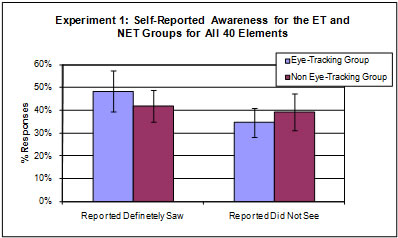
Figure 3. Average self-reported awareness of ET vs. NET groups for Experiment 1 (error bars represent 95% confidence intervals)
Figure 4 shows the responses of the ET and NET groups for Experiment 2. ET participants reported spending a long time looking at the elements (top 2 box response) about 17% of the time, compared to 21% of the time for the NET group. This difference was not statistically significant, t(38) = 0.89, p = 0.38. ET participants reported spending little or no time looking (bottom 2 box response) at the elements 66% of the time, compared to 62% of the time for the NET group. This difference also was not statistically significant, t(38) = 0.74, p = 0.46. Similar to Experiment 1, there was no data to suggest that there was a significant impact of eye tracking on participants responses to the question posed in Experiment 2.
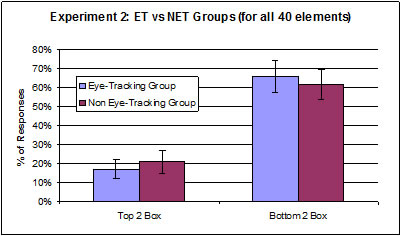
Figure 4. Average self-reported awareness of ET vs. NET groups for Experiment 2 (error bars represent 95% confidence intervals)
Even though there was not a statistical difference between the ET and NET groups for either Experiment 1 or 2, NET participants trended towards more likely to say they definitely saw an element and spent a long time looking at an element. This was not surprising because the NET group knew there was no way their responses could be validated. We speculated that ET participants tended to be slightly more conservative in their responses. Because this was only a slight trend, it was safe to assume that any results of the ET-only data would generalize to typical testing situations in which participants were not being eye tracked.
Fixation Count
Fixation count is one type of data that is calculated from the eye tracking software. Fixation count refers to the total number of fixations a participant has on a pre-defined Area of Interest (AOI). All 40 of the elements were individually defined as AOIs. A fixation is defined by a time parameter. The system default of 100 ms was used in both experiments. Therefore, a fixation was defined as having fixated in a given area for at least 100 ms.
The first test on the reliability of self-reported awareness was based on fixation count. If there was no difference in fixation count based on how they responded to the questions in Experiments 1 and 2, we concluded that there was absolutely no reliability in their self-reported awareness. If we did observe a difference in fixation count, we concluded that, at a minimum, there was a difference in eye movement patterns based on a self-reported awareness response. For all of these analyses, we excluded the 7 “fake” elements that were used as part of the memory test.
In Experiment 1, participants who responded that they definitely saw an element had an average of 2.3 fixations, compared to 0.9 fixations for those who responded that they did not see an element (see Figure 5). This difference was statistically significant, t(38) = 5.45, p < 0.001.

Figure 5. Average fixation counts for Experiment 1 by response type (error bars represent the 95% confidence interval)
In Experiment 2, participants who indicated that they spent a long time looking at an element (top 2 box), had an average of 2.7 fixations, compared to 1.3 fixations for those that responded that they spent little or no time (bottom 2 box) looking at an element (see Figure 6). This difference was statistically significant, t(38) = 4.43 p < 0.001.
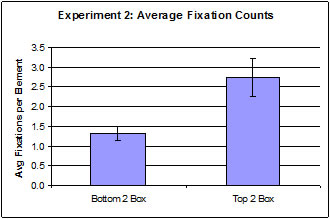
Figure 6. Average fixation counts for Experiment 2 by response type (error bars represent the 95% confidence interval)
Overall, the number of fixations per element differed significantly for both response types in Experiments 1 and 2. This finding shows that there is at least some level of reliability for self-reported awareness measures based on fixations.
Gaze Duration
To further test minimal reliability of self-reported awareness, gaze duration was examined. Gaze duration is the total time spent fixating within any AOI or element. Gaze duration could include one or more consecutive or non-consecutive fixations on a single AOI. For example, a participant could fixate on the element for 230 ms, focus their attention on another area of the webpage, and then re-focus their attention within the AOI for another 270 ms, resulting in total gaze duration of 500 ms. Similar to fixation counts, we excluded the 7 fake elements that were used as part of the memory test.
In Experiment 1, participants who responded that they did not see an element spent a total of about 200 ms fixating on that element, compared to 510 ms for those responding that they definitely saw an element (see Figure 7). This difference was statistically significant, t(38), = 4.49, p < 0.001.
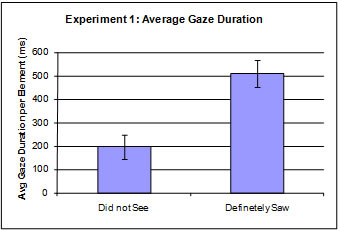
Figure 7. Average gaze duration for Experiment 1 by response type (error bars represent the 95% confidence interval)
In Experiment 2, participants who responded that they spent little or no time looking at a particular element (bottom 2 box) had an average gaze duration of about 290 ms, compared to a gaze duration of about 615 ms for those participants who spent a significant amount of time looking at an element (top 2 box) (see Figure 8). This difference was also statistically significant, t(38), = 4.65, p < 0.001.
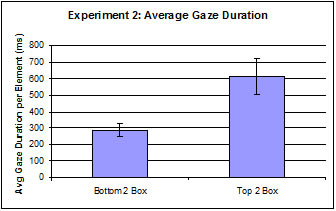
Figure 8. Average gaze duration by response type for Experiment 2 (error bars represent the 95% confidence interval)
Results of the gaze duration analysis were consistent with fixation counts. Participants who responded that they spent a significant amount of time looking at an element (top 2 box) had an average gaze duration more than twice that of those that responded having spent little or no time looking at an element.
Although this was not surprising, it was an affirmation that people’s recollections of the elements have some basis in eye movements, as measured by both fixation count and gaze duration, and weren’t completely mistaken.
Overall, we felt confident that there was a minimum level of reliability of self-reported awareness measures. However, having a minimum level of confidence was not enough to justify the use of self-reported awareness questions during a usability evaluation. Therefore, we decided to take a more in-depth look at the different types of responses made by participants.
Response Outcomes
A more rigorous examination of the reliability of self-reported awareness was made by categorizing each response relative to gaze duration. The following were the four types of outcomes in this analysis (see Table 2):
- A false alarm occurred when the participant reported noticing an element, yet had a gaze duration = 0 ms. In other words, the participant said s/he definitely saw it (Experiment 1) or spent a long time looking at it (top 2 box response in Experiment 2), yet spent absolutely no time fixating on any part of the element.
- A miss occurred when the participant responded that s/he did not see an element, yet had a gaze duration > 500 ms. Because research shows that it takes from 0 to 250 ms to process elements (see discussion below), we assumed that 500 ms was a more than adequate amount of time for someone to process the basic characteristics of an element.
- A hit happened when the participant responded that they noticed the element (Experiment 1) or spent a significant time looking at the element (Experiment 2), and had a gaze duration > 250 ms.
- A correct rejection occurred when the participant responded not having seen the element (Experiment 1) or spent no time looking at an element (Experiment 2), and had a gaze duration < 250 ms.
False alarms and misses could be collectively thought of as the overall error rate, because participants either remembered an element they didn’t see (false alarm) or didn’t remember an element they did fixate on (miss). Conversely, a success rate was based on the combination of hits and correct rejections.
It should be noted here that there is varying research regarding appropriate parameters of gaze duration to measure attention. The “eye-mind hypothesis” (Just & Carpenter, 1980) suggested that people process words and other information instantaneously upon seeing them (a 0 ms duration), while other research has used or suggested up to 250 ms for text (Guan et al., 2006; Johansen & Hansen, 2006; Rayner & Pollatsek, 1989) and 100 ms for pictures, graphs, or numerical data (Guan et al., 2006). In the categorization scheme above, the criteria used to define each outcome were somewhat arbitrary, but with these researched parameters as guidance. For this study, we adopted a liberal definition of what we considered a success (250 ms cutoff), and a conservative definition of what we considered an error (up to 500 ms for a miss). Essentially, we wanted to give the participants the benefit of the doubt wherever possible.
Table 2. Categorization of Error and Success Types for Experiments 1 and 2

For Experiment 1, there was an overall error rate of 15% (see Table 3). There was roughly twice the number of false alarms (10.2%) as misses (4.8%). The success rate in Experiment 1, approximately split between correct rejections and hits, was 55.2%.
Table 3. Response Outcomes for Experiment 1

The overall error rate in Experiment 2 was 17.4% (see Table 4). Similar to Experiment 1, participants made about half as many false alarms (4.8%) as misses (12.6%). The overall success rate was 33.8%, with roughly more than twice as many correct rejections (22.1%) as hits (11.7%).
Table 4. Response Outcomes for Experiment 2

Short of performing an in-depth Signal Detection Theory analysis, we derived some important themes from this data. Roughly 5% to 10% of the time, participants said they definitely saw or spent a long time looking at an element when, in fact, they did not see it at all (false alarms). Participants indicated that they did not see the element, or spent no time looking at something, when in fact they did 4.8% (Experiment 1) or 12.6% (Experiment 2) of the time. Taken together, there was an overall error rate of 15% (Experiment 1) to 17% (Experiment 2).
Even though words and images may be easily encoded into memory in less than 500 ms, it was possible that participants fixated with little or no attention. To be even more conservative in how we classified errors, we adjusted the threshold for misses up to 1,000 ms. For Experiment 1, the miss rate dropped from 4.8% down to 1.1%. For Experiment 2, the miss rate dropped from 12.6% down to 5.8%. When adopting this highly conservative approach to classifying errors, the overall error rate was 11.3% in Experiment 1 and 10.6% in Experiment 2.
A substantial decrease in the miss rate was not surprising because the greater the fixation time, the less likely a participant reported definitely not noticing an element (Experiment 1) or spending no time looking at an element (Experiment 2). Essentially, the longer you spend looking at something, the more likely you are to notice it. Of course, it was still possible that participants looked at an element for 500 ms or even a full second and did not fully process the most basic characteristics.
Element Types
Is it possible that participants can be trusted with their self-reported awareness for just certain types of elements? To answer this question we decided to look at the following three specific types of elements:
- Functional elements: features that are intended to be interacted with such as a search box or drop-down menu.
- Navigation elements: primary navigation areas that are on a website such as tabs or left-side navigation links.
- Image elements: ads or images associated with content.
Experiment 1 showed a roughly equal error rate (false alarms + misses) for each element type (12% to 14% overall error) (see Figure 9). One interesting point was that functional elements tended to have a much greater proportion of false alarms compared to misses.
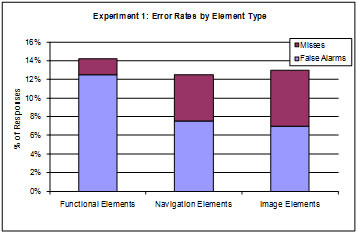
Figure 9. Overall error rates by element type for Experiment 1
Experiment 2 showed greater variability in the overall rate across the three element types (see Figure 10). Navigation elements had an overall rate just under 6%, while functional elements were about 11%. In both Experiments, error rates for functional elements were the highest.
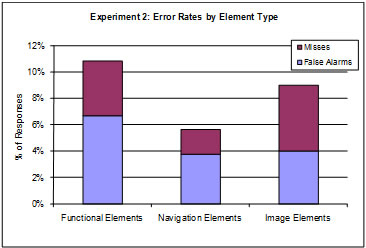
Figure 10. Overall error rates by element type for Experiment 2
Memory Test
A memory test was also used to test the reliability of self-reported awareness. By asking participants if they saw an element that did not exist, we were able to accurately determine the reliability of their responses. We treated the memory test as a separate analysis from the other elements. Taking the responses to the seven new elements used across both the ET and NET groups, we simply derived the percentage of the time participants claimed that they definitely saw it (Experiment 1) or spent a long time looking at it (top 2 box for Experiment 2).
The results of the memory test are shown in Table 5. Experiment 1 resulted in 27% of the responses saying that they definitely saw an element that did not exist in the study slide. Experiment 2 produced a lower false alarm rate; 9% of the responses said that they spent a significant amount of time looking at an element (top 2 box response) that did not exist.
Table 5. Response for Memory Test (ET and NET Groups Combined)

Discussion
So, what does all of this mean? To make sense of the data, we must first consider the context of false alarms and misses. In a user-centered design process, false alarms are almost always more relevant than misses. Let’s look at two different scenarios. In a false alarm scenario, a design team wants to test if a particular object is noticed. During a usability evaluation they ask participants whether or not they noticed a particular object. Some participants may say they noticed the object, but did not. In this scenario, the design team may incorrectly conclude that the object is visually prominent enough, and no steps are required to increase its visual prominence. In a miss scenario, a design team wants to make sure that an object is not noticed. They run a usability evaluation and ask the participants if they noticed a particular object. Some of the participants report not seeing the object, whereas they actually did notice it. This would result in the design team incorrectly deciding not to make the object more hidden.
Based on our experience, the false alarm scenario is fairly common in usability evaluations, whereas the miss scenario is extremely unlikely. In order for the miss scenario to occur, a design team would have a goal of making an object difficult to notice. This certainly can happen, particularly if a designer is trying to make certain warnings or cost information appear less prominent. We certainly don’t endorse this design approach, but it does happen. In the miss scenario, the participant would also have some motivation for not saying they saw something that they actually did. This could conceivably happen if the participant was embarrassed in some way. Because both of these conditions are very unlikely to occur together within a single scenario, we feel that analyzing misses as part of an overall error rate is misleading. Therefore, we believe examining false alarms, and not misses, is more realistic and useful to the practitioner.
When considering only false alarms the picture is much clearer. In Experiment 1, there was a false alarm rate of 10%, and in Experiment 2 there was a false alarm rate of 5%. In other words, using either awareness question, the practitioner will not draw the incorrect conclusion more than 10% of the time. In Experiment 1 the success rate was 55% and 29% in Experiment 2. Therefore, the practitioner can make a tradeoff. If a practitioner wants to be very conservative and minimize false alarms, they should consider asking an awareness question based on a more continuous scale, similar to Experiment 2. The downside is that they will be less likely to be able to confirm participants who actually said they saw it or did not see it. If the practitioner is willing to accept a higher false alarm rate using a more discrete awareness scale, they will better be able to confirm that participants noticed or did not notice an element.
The false alarm rate for navigation and image elements was lower in both experiments than functional elements. In Experiment 1 the false alarm rates were about 7% for both the navigation and image elements. In Experiment 2 the false alarm rates were about 4% for the same elements. This is very encouraging, suggesting that there are certain elements that produce highly reliable results, regardless of how the question is structured.
The memory test focused only on false alarms. It was interesting to see that the false alarms were considerably higher in Experiment 1 (27%) compared to Experiment 2 (9%). This suggests that a more continuous scale may tease apart those participants that are much more confident, and those participants that might be a little less confident in their awareness for a particular object. Perhaps the discrete nature of Experiment 1 is pulling those participants that think they saw the object, but may not be sure, into the category of definitely saw it.
Limitations and Next Steps
There were a few limitations to this study. First, the dependent measures of fixation counts and gaze duration were not ideally suited for confirming lack of awareness. It was quite possible that an individual fixated on an element, yet was not attending or processing the information. Therefore, there was a certain level of noise represented in miss errors. Second, it was possible that usability participants exhibited different eye movement patterns and awareness levels when performing tasks, as compared to general orientation. While general orientation was quite common, particularly for new visitors to a website, it only represented one type of activity on a website. Third, it was possible that participants may have been familiar with some of the websites used in the study. When asked about their awareness, they may have been responding from long term memory. This could have resulted in false alarm errors. Basically, they said they saw it, because they remembered it from some past experience, yet had no fixations on it.
There are several directions for future research. To further validate the findings in this paper, we suggest studying the impact of task-driven behavior on the reliability of self-reported awareness measures. Also, we would like to expand the type of elements. For example, it is possible that self-reported awareness of images of faces may be more reliable. Finally, it would be helpful to develop other types of measures of awareness. While we only tested two measures, it is quite possible that other measures may produce more reliable results.
Conclusion
Asking usability participants if they noticed a particular element on a website or software application is common practice. Often times this information is the basis for important design decisions, particularly around making certain features more visually prominent. This study has clearly demonstrated that there is reliability in self-reported awareness measures. Usability practitioners should feel comfortable that at least most of the time when a participant reports seeing an object, that they actually did. This will in turn help practitioners make more confident design decisions.
The manner in which the usability practitioner asks a participant about whether or not they noticed an object will have an impact on what is reported back to them. If a practitioner wants to identify as many participants as possible who saw an object, with less regard for accuracy, they should use an awareness question that is more discrete in nature. If a practitioner wants to be as confident as possible in those participants that report seeing an object, that actually did, they should use an awareness question that is more continuous in nature.
We do not suggest that one simple self-report awareness question can be a substitute for the reliability and versatility of an eye tracking system. There are many other research questions about awareness that can only be effectively answered using an eye tracking system. Asking a participant about awareness certainly may be useful during the course of a usability evaluation, but it is only the start in regards to all the questions a practitioner might have about how users look at a design.
References
- Brooke, J. (1996). SUS: a “quick and dirty” usability scale. In P.W. Jordan, B. Thomas, B.A. Weerdmeester & A.L. McClelland (Eds.) Usability Evaluation in Industry (pp. 189-194). London: Taylor and Francis.
- Guan, Z., Lee, S., Cuddihy, E., & Ramey, J. (2006, April). The Validity of the Stimulated Retrospective Think-Aloud Method as Measured by Eye Tracking. In R. Grinter, T. Rodden, P. Aoki, E. Cutrell, R. Jeffries, and G. Olson, (Eds.) Proceedings of the SIGCHI Conference on Human Factors in Computing Systems, 2006 (pp.1253-1262) New York, New York, USA. ACM Press.
- Johansen, S., & Hansen, J.P. (2006, April). Do we need eye trackers to tell where people look? In CHI ’06 Extended Abstracts on Human Factors in Computing Systems (pp.923 – 928) New York, New York, USA. ACM Press.
- Just, M.A., & Carpenter, P.A. (1980). A theory of reading: From eye fixations to comprehension, Psychological Review, 87(4), 329-354.
- Norgaard, M., & Hornbaek, K. (2006, June). What do usability evaluators do in practice?: an explorative study of think-aloud testing. In Proceedings of the 6th Conference on Designing Interactive Systems (pp.209-218) New York, New York, USA. ACM Press.
- Rayner, K., & Pollatsek, A. (1989). The Psychology of Reading. USA: Prentice-Hall.
- Tedesco, D., & Tullis, T. (2006, June). A Comparison of Methods for Eliciting Post-Task Subjective Ratings in Usability Testing. In Proceedings of the Usability Professionals Association (UPA), USA.
- Tullis, T., & Stetson, J. (2004, June). A Comparison of Questionnaires for Assessing Website Usability. In Proceedings of the Usability Professionals Association (UPA), USA.
- Wilson, T. (2004). Strangers to Ourselves: Discovering the Adaptive Unconscious. USA: Belknap Press.
